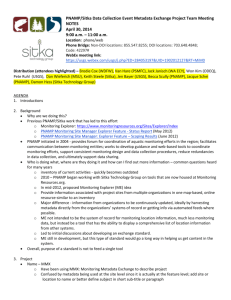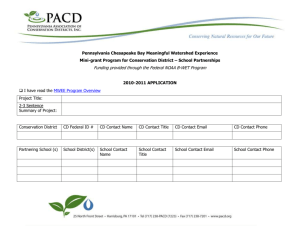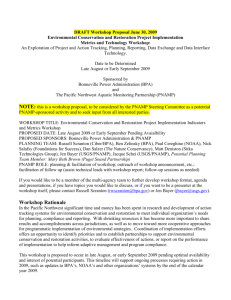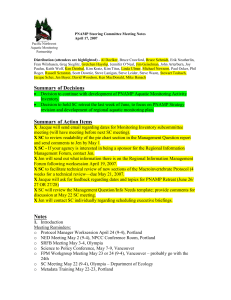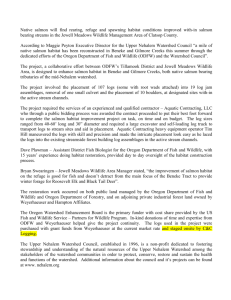2009_0304ManuscriptTitlesAuthorsTTM
advertisement
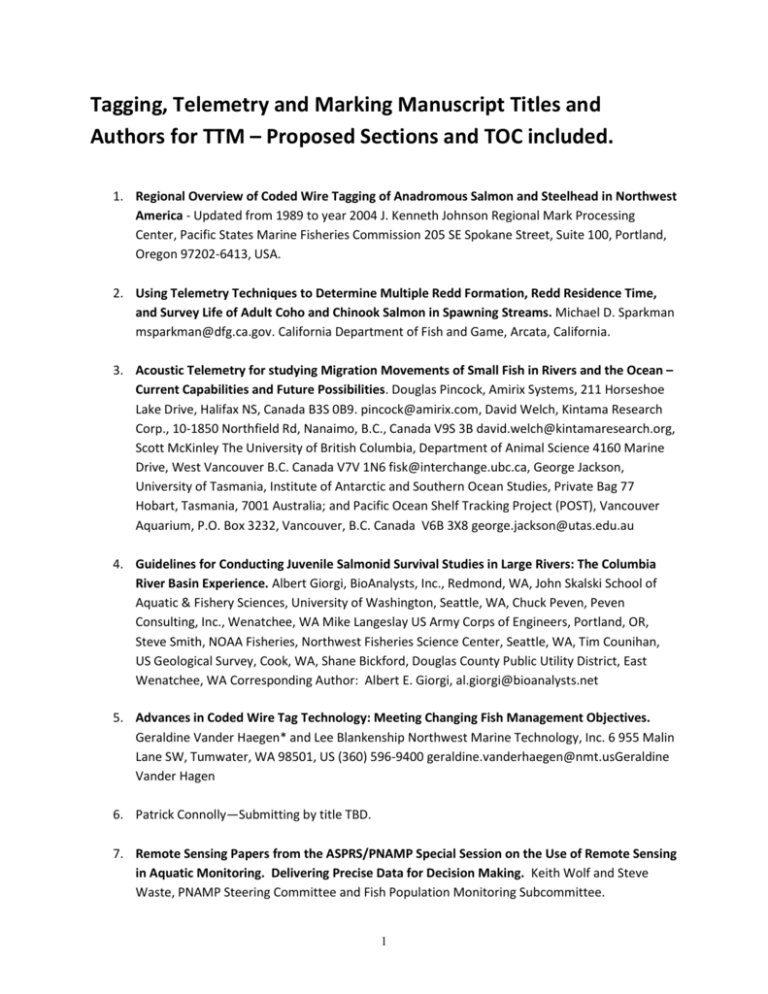
Tagging, Telemetry and Marking Manuscript Titles and Authors for TTM – Proposed Sections and TOC included. 1. Regional Overview of Coded Wire Tagging of Anadromous Salmon and Steelhead in Northwest America - Updated from 1989 to year 2004 J. Kenneth Johnson Regional Mark Processing Center, Pacific States Marine Fisheries Commission 205 SE Spokane Street, Suite 100, Portland, Oregon 97202-6413, USA. 2. Using Telemetry Techniques to Determine Multiple Redd Formation, Redd Residence Time, and Survey Life of Adult Coho and Chinook Salmon in Spawning Streams. Michael D. Sparkman msparkman@dfg.ca.gov. California Department of Fish and Game, Arcata, California. 3. Acoustic Telemetry for studying Migration Movements of Small Fish in Rivers and the Ocean – Current Capabilities and Future Possibilities. Douglas Pincock, Amirix Systems, 211 Horseshoe Lake Drive, Halifax NS, Canada B3S 0B9. pincock@amirix.com, David Welch, Kintama Research Corp., 10-1850 Northfield Rd, Nanaimo, B.C., Canada V9S 3B david.welch@kintamaresearch.org, Scott McKinley The University of British Columbia, Department of Animal Science 4160 Marine Drive, West Vancouver B.C. Canada V7V 1N6 fisk@interchange.ubc.ca, George Jackson, University of Tasmania, Institute of Antarctic and Southern Ocean Studies, Private Bag 77 Hobart, Tasmania, 7001 Australia; and Pacific Ocean Shelf Tracking Project (POST), Vancouver Aquarium, P.O. Box 3232, Vancouver, B.C. Canada V6B 3X8 george.jackson@utas.edu.au 4. Guidelines for Conducting Juvenile Salmonid Survival Studies in Large Rivers: The Columbia River Basin Experience. Albert Giorgi, BioAnalysts, Inc., Redmond, WA, John Skalski School of Aquatic & Fishery Sciences, University of Washington, Seattle, WA, Chuck Peven, Peven Consulting, Inc., Wenatchee, WA Mike Langeslay US Army Corps of Engineers, Portland, OR, Steve Smith, NOAA Fisheries, Northwest Fisheries Science Center, Seattle, WA, Tim Counihan, US Geological Survey, Cook, WA, Shane Bickford, Douglas County Public Utility District, East Wenatchee, WA Corresponding Author: Albert E. Giorgi, al.giorgi@bioanalysts.net 5. Advances in Coded Wire Tag Technology: Meeting Changing Fish Management Objectives. Geraldine Vander Haegen* and Lee Blankenship Northwest Marine Technology, Inc. 6 955 Malin Lane SW, Tumwater, WA 98501, US (360) 596-9400 geraldine.vanderhaegen@nmt.usGeraldine Vander Hagen 6. Patrick Connolly—Submitting by title TBD. 7. Remote Sensing Papers from the ASPRS/PNAMP Special Session on the Use of Remote Sensing in Aquatic Monitoring. Delivering Precise Data for Decision Making. Keith Wolf and Steve Waste, PNAMP Steering Committee and Fish Population Monitoring Subcommittee. 1 8. TTFG paper in coordination with ISRP/AB’s programmatic review 9. EAARL Systems (possible) 10. Wetland Delineation (possible) Other possible abstracts proceedings from AFS: 11. Using hydroacoustic telemetry tools to understand movement and ecology of critical species and improve Management applications. Short title: Methods of Fish Tracking Moderator: Anna Kagley, NOAA/NMFS/FE Division (anna.kagley@noaa.gov, (206) 860-3291) 12. Spatial and temporal movements of adult spring Chinook salmon in the upper Yakima River. Steve Corbett.Lyn McComas Geoff McMichael 13. Migration pathways of acoustic-tagged juvenile salmonids in the Columbia Estuary. Ryan Harnish, Gary Johnson & Geoff McMichael 14. Jessica Carter, Ryan Harnish, Gary Johnson & Geoff McMichael. Use of acoustic telemetry to assess migratory behavior of sub-yearling Chinook salmon at the mouth of the Columbia River. 15. Anna Kagley, Fred Goetz, Correigh Greene, Tom Quinn, Joshua Chamberlin and Kurt Fresh. A summary of acoustic tagging programs for migratory and resident Chinook salmon in Puget Sound. 16. Fred Goetz, Tom Quinn, Skip Tezak, Megan Moore & Barry Berejikian. Nearshore habitat use and behavior of Hood Canal Cutthroat Trout 17. Anne Beaudreau & Tim Essington. The role of lingcod foraging in linking demersal and pelagic fish communities of the San Juan Archipelago, Washington. 18. Kelly Andrews, Greg Williams, & Phil Levin. Patterns of behavior in sixgill sharks, spiny dogfish and ratfish: patterns, causes and ecosystem consequences. 19. Jennifer Scheuerell & Cris Ewing of Sound Data Management LLC. The Hydrophone Data Repository (hydra.sounddatamanagement.com): demonstration of a new research collaboration website 2 Remote Sensing Special Section: 20. Characterizing Submerged Benthic Habitats - Amar Nayegandhi, U.S. Geological Survey High Resolution Mapping and Interpretation of Channel and Floodplain Topography with a NarrowBeam Terrestrial-Aquatic Lidar - Dan Isaak, USDA Forest Service 21. Application and Evaluation of the EAARL Lidar for Change Detection and Hydraulic Modeling in a Shallow, Braided River - Paul Kinzel, U.S. Geological Survey 22. Using Bathymetric and Bare Earth Lidar in Priarian Corridors: Applications and Challenges Jennifer Bountry, U.S. Bureau of Reclamation 23. Using High Spatial Resolution Compact Airbourne Spectrographic Imager (CASI) Imagery to Examine Patterns in Eelgrass Beds in Hood Canal, WA - Ralph Garono, Earth Design Consultants, Inc. 24. Using Remotely Sensed Landscape Variables to Assess Anthropogenic Influences on In-Stream Water Temperature in the John Day River- Mimi D’Iorio, NOAA 25. Modeling Watershed Condition and Trend - Peter Eldred, USDA Forest Service Integrating Existing Vegetation Maps and Models of Vegetation Dynamics for Watershed Assessment Melinda Moeur, USDA Forest Service 26. Application of SHOALS Technology to Fisheries Studies in the Handord Reach of the Columbia River - Paul Wagner and Keith Wolf KWA Ecological Sciences, Inc. & Ken Tiffan, U.S. Geological Survey 27. Assessment of Airborne Lidar Data and High-resolution Digital Imagery for Aquatic Habitat Monitoring in the Pacific Northwest - Russ Faux, Watershed Sciences, Inc. 28. Managing, Manipulating, and Serving Lidar Terrain and Orthoimagery Data for Riverine Habitat Assessment and Remediation Project Design for Salmon Recovery in the Pacific Northwest - Mike Beaty & Kristin Swoboda, U.S. Bureau of Reclamation 29. Using High Spatial Resolution Compact Airbourne Spectrographic Imager (CASI) Imagery to Examine Patterns in Eelgrass Beds in Hood Canal, WA - Ralph Garono, Earth Design Consultants, Inc. 30. Using Remotely Sensed Landscape Variables to Assess Anthropogenic Influences on In-Stream Water Temperature in the John Day River- Mimi D’Iorio, NOAA 31. Modeling Watershed Condition and Trend - Peter Eldred, USDA Forest Service Integrating Existing Vegetation Maps and Models of Vegetation Dynamics for Watershed Assessment Melinda Moeur, USDA Forest Service 3 32. Special Session Report-PNAMP (RH), 2008 Publication Format (proposed for ERC discussion) Cover Page with Art PNAMP and BPA Funding Assistance Acknowledgement and PNAMP statement of purpose (one – paragraphs that provides the PNAMP and BPA F/W web links, some information on Mission and the affiliated people and agencies involved in this effort and in PNAMP (much crossover) Table of Contents Forward (ISRP/AB) Acknowledgements (PNAMP FPM – assigned author TBD) Preface (possible depending upon ISRP/AB forward) We have one draft for holding place since ISRP/AB will come in June which is late in the schedule (TBD) Note on e-publication and its advantages, peer review processes and scholarly approach Acronyms (if funding, participation and time allow- assigned author TBD) Glossary (if funding, participation and time allow- assigned author TBD) Intoduction (Wolf and O’Neal) Chapter 1 (not sure we have enough variety for “sections.” Recommend “Chapters”) Chapter 2 (see manuscript list) Chapter 3 Chapter 4 Chapter x Special Section on Remote Sensing (telemetry) (Jen Bayer, R. Haggerund) Editorial and Review Committee Compiled Summary Chapter (all reviewers are the authors) Appendices 4
